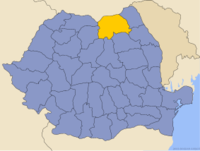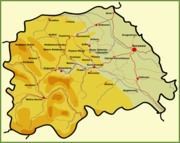
Polish minority in Romania
Encyclopedia


Poles
thumb|right|180px|The state flag of [[Poland]] as used by Polish government and diplomatic authoritiesThe Polish people, or Poles , are a nation indigenous to Poland. They are united by the Polish language, which belongs to the historical Lechitic subgroup of West Slavic languages of Central Europe...
live in Romania
Romania
Romania is a country located at the crossroads of Central and Southeastern Europe, on the Lower Danube, within and outside the Carpathian arch, bordering on the Black Sea...
, mainly in the villages of the Suceava region . There are even three exclusively Polish villages: Nowy Sołoniec (Soloneţu Nou), Plesza (Pleşa) and Pojana Mikuli (Poiana Micului). Poles in Romania form an officially recognised national minority, having one seat in the Chamber of Deputies of Romania
Chamber of Deputies of Romania
The Chamber of Deputies is the lower house in Romania's bicameral parliament. It has 315 seats, to which deputies are elected by direct popular vote on a proportional representation basis to serve four-year terms...
(currently held by Gerwazy Longher) and access to Polish elementary schools and cultural centres (known as "Polish Houses").
History
The first Poles settled in BukovinaBukovina
Bukovina is a historical region on the northern slopes of the northeastern Carpathian Mountains and the adjoining plains.-Name:The name Bukovina came into official use in 1775 with the region's annexation from the Principality of Moldavia to the possessions of the Habsburg Monarchy, which became...
in the times of Casimir III
Casimir III of Poland
Casimir III the Great , last King of Poland from the Piast dynasty , was the son of King Władysław I the Elbow-high and Hedwig of Kalisz.-Biography:...
. Most of the Poles immigrating after 1774 were looking for work. Polish miners from Bochnia
Bochnia
Bochnia is a town of 30,000 inhabitants on the river Raba in southern Poland. The town lies approximately in halfway [] between Tarnów and the regional capital Kraków . Bochnia is most noted for its salt mine, the oldest functioning in Europe, built circa 1248...
and Wieliczka
Wieliczka
-External links:***...
were brought to salt mines in Cacica . Another wave of Polish immigration arrived in Bukovina in the early 19th century, when the region was part of the Austro-Hungarian Empire, as was a significant portion of Poland. Around 1803 Polish highlanders from Čadca
Cadca
Čadca is a district town in northern Slovakia, near the border with Poland and the Czech Republic.-Geography:It is located south of the Jablunkov Pass, surrounded by the Javorníky, Kysucké Beskydy and Turzovská vrchovina mountain ranges. It lies in the valley of the Kysuca river, around 30 km...
settled in Treblecz (Tereblecea) by Siret
Siret
Siret is a town in Romania, Suceava County, one of the oldest towns in, and a former capital of, the former principality of Moldavia. It is located 2 km from the border with Ukraine, being one of the main border passing points in the North of the country, having both a road border post and a...
, in Stara Huta Krasna and in Kaliczanka and again in 1814-1819, this time settling in Hliboka (Adancata) and Tereszna. Nowy Sołoniec was settled in 1834, Plesza in 1835 and Pojana Mikuli in 1842.
Southern Bukovina was a very attractive place to live in because of Austria's policy not to conscript recruits into its army from there (service in the Austrian army at that time was for a 14-year term). Moreover, Bukovina was free from serfdom
Serfdom
Serfdom is the status of peasants under feudalism, specifically relating to Manorialism. It was a condition of bondage or modified slavery which developed primarily during the High Middle Ages in Europe and lasted to the mid-19th century...
, attracting immigrants of German
Germans
The Germans are a Germanic ethnic group native to Central Europe. The English term Germans has referred to the German-speaking population of the Holy Roman Empire since the Late Middle Ages....
, Jewish, Czech
Czech people
Czechs, or Czech people are a western Slavic people of Central Europe, living predominantly in the Czech Republic. Small populations of Czechs also live in Slovakia, Austria, the United States, the United Kingdom, Chile, Argentina, Canada, Germany, Russia and other countries...
, Slovak
Slovaks
The Slovaks, Slovak people, or Slovakians are a West Slavic people that primarily inhabit Slovakia and speak the Slovak language, which is closely related to the Czech language.Most Slovaks today live within the borders of the independent Slovakia...
, Russian
Russians
The Russian people are an East Slavic ethnic group native to Russia, speaking the Russian language and primarily living in Russia and neighboring countries....
, Italian
Italian people
The Italian people are an ethnic group that share a common Italian culture, ancestry and speak the Italian language as a mother tongue. Within Italy, Italians are defined by citizenship, regardless of ancestry or country of residence , and are distinguished from people...
, and Polish nationality.
There were probably other waves of migration from Poland after the November
November Uprising
The November Uprising , Polish–Russian War 1830–31 also known as the Cadet Revolution, was an armed rebellion in the heartland of partitioned Poland against the Russian Empire. The uprising began on 29 November 1830 in Warsaw when the young Polish officers from the local Army of the Congress...
and Kraków Uprising
Kraków Uprising
The Kraków Uprising of February 1846 was an attempt, led by Edward Dembowski, to incite a Polish fight for national independence. Even though most of Poland was part of the Russian Empire, the Polish risings were conducted mainly in Prussia and in the Austrian Empire.-History:Most of the...
s, but most Poles were from peasant families relocated there by the Empire's authorities after they participated in the Jakub Szela
Jakub Szela
Jakub Szela was a Polish leader of a peasant uprising against the gentry in Galicia in 1846; directed against manorial property and rising against serfdom; scores of manors were attacked and their inhabitants murdered...
insurrection. There were about 80,000 Poles living in Romania in 1939, but only about 11,000 remained in 1949 after Romania lost Bessarabia
Bessarabia
Bessarabia is a historical term for the geographic region in Eastern Europe bounded by the Dniester River on the east and the Prut River on the west....
and Northern Bukovina (the most important Polish community lived in Czerniowce, now in Ukraine).
Notable Polish-Romanians
- Michał Belina-Czechowski, Seventh-Day Adventist preacher
- Tytus Czerkawski, politician
- Matilda Cugler-Poni, poet and actress
- Izydor Kopernicki, physician
- Ghervazen LongherGhervazen LongherGhervazen Longher is a Romanian politician, and a political leader of the Polish minority in Romania. He has been a member of the Chamber of Deputies since 2004.- References :...
, politician - Iosif Malinovski, Roman Catholic vicar and publisher
- Gustav Otremba, physician
- Witold Rola Piekarski, cartoonist and academic
- Feliks Wierciński, Roman Catholic priest and schoolteacher

